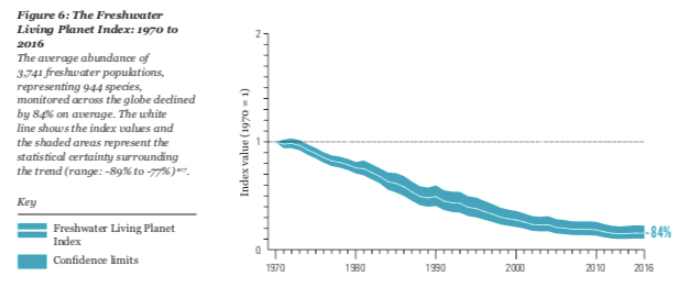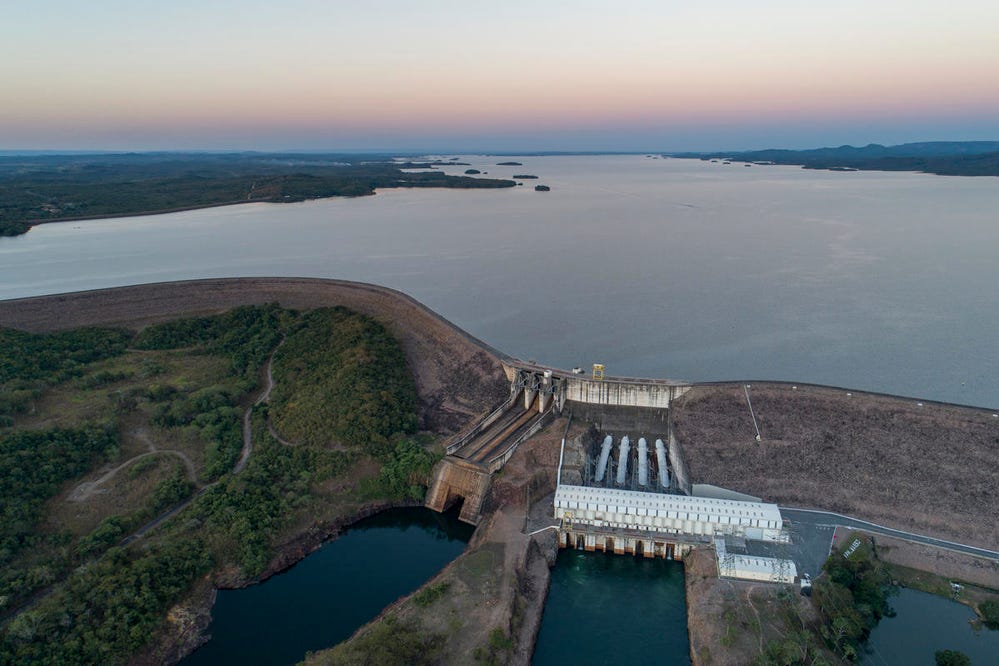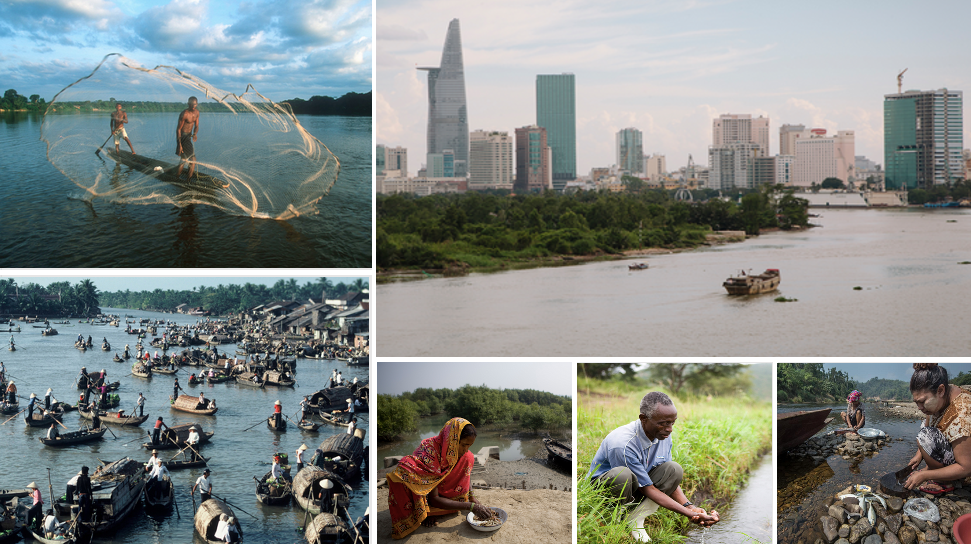By Stuart Orr, WWF’s Global Freshwater Lead,
© naturepl.com / Kevin Schafer / WWF. © Jaime Rojo / WWF-USWWF’s new Living Planet Report has confirmed our worst fears. Freshwater species populations are continuing to plummet — now down 84% on average in the past 50 years. While that shocking statistic tells the story of decades of decline in the overall abundance of freshwater life, it also includes tales of extinction, including this year’s biggest loss — the Yangtze Paddlefish. Sadly, too many other freshwater species are heading for the same fate.
It’s no coincidence that confirmation of the ongoing collapse in freshwater species comes just a couple of months after the UN announced that the world was still way off track in terms of SDG6 — providing water for all. Few people connect the two, but the loss of freshwater biodiversity is the clearest sign that we are not on course to achieve that essential goal. Destroying the freshwater ecosystems that our societies and economies depend on is no pathway to sustainable development.
Water sustainability has to incorporate the protection of ecosystems, and yet water planners, development agencies and governments continue to treat water as solely an economic input, nothing more. Rivers are regarded as little more than pipes and sewers, wetlands as wasted space to pave over or drain, floodplains as ready-made sites for housing developments. The result: the rivers, lakes and wetlands that literally sustain life are being wrecked by short-sighted policies and projects.
How do we know? Because they now contain only 16% of the biodiversity that was in them in 1970.

It’s almost impossible to comprehend that we have lost so much. It’s even more incomprehensible that our dying rivers, lakes and wetlands continue to be so undervalued and overlooked. Our civilizations were founded on rivers. Our greatest cities developed around them. Healthy rivers provide humanity with a host of priceless benefits beyond just water, such as freshwater fisheries that feed tens of millions, fertile floodplain fields, resilient deltas, and protection from extreme floods and droughts. They also sustain extraordinary biodiversity. Or rather, did.
How do we cure this water blindness? Make people see the real value of water? Perhaps the COVID-19 pandemic will open people’s eyes since it has highlighted once again the importance of clean water to human health. But we have always known this. Yet, three billion people still lack basic handwashing facilities and water-borne diseases remain some of the top killers around the world.
I used to think that businesses and financiers would listen to the World Economic Forum, which has spent the past decade warning about the risk that water crises pose to the global economy. But very few companies seem to have taken any heed, let alone dipped their toes into tackling their water addiction.
Nor does the donor community have much to crow about. Too many water development projects have polluted, dammed, diverted and destroyed vital water ecosystems without a thorough understanding of what their actions meant or what problems they would ultimately create. How many environmental impact assessments (of those that there were actually conducted) on dams, navigation channels and flood defences ever delved into the impacts beyond the immediate project surroundings? River dynamics, natural flood pulses, sediment flows, and freshwater fisheries — and the needs and rights of countless communities that relied on them — were regarded as insignificant. Or not factored in at all. And they still aren’t so decision-makers keep making the same mistakes.

Let’s take the Mekong: a river that is being strangled to death by development projects that were supposed to make life better for the most vulnerable. Poorly-planned hydropower dams are devastating the world’s largest freshwater fishery and — combined with unsustainable sand mining — starving the delta of the sediment it needs to stay above the rising seas. The result? The food security and livelihoods of millions are at risk, along with thriving economies and one of the richest rice baskets in the world. In many cases the very land under people’s homes and feet is being eroded, while saltwater floods into their fields. All because decades of development projects upstream forgot they mattered.
Needless to say, freshwater biodiversity in the Mekong has been flashing warning signs for years. River dolphins are now confined to Cambodia and number less than 100. The river’s iconic fish — the Giant Catfish, Giant Stingray, Giant Barb and wonderfully named Dog-eating Catfish — have all but disappeared.
And yet, new mega-dams are still planned on the Mekong in Laos — ignoring the devastating impacts on people (and mega-fish) downstream — even though the plunging cost of low-impact renewables, like solar and wind, means there are now alternatives to harmful hydropower.
We believed that our decisions to dam and divert rivers for power and irrigation were trade-offs worth having. And many of them were. But I — and a growing number of others — are tired of trading-off our remaining free flowing rivers, healthy wetlands and freshwater biodiversity for more poor development choices. Because there are effective solutions, innovations and alternatives — not to mention the science and evidence that shows that our approach to water has not worked.
As conservationists, we must examine and be honest about where our own efforts have fallen short. At the same time, we have to shout loudly about the fact that it is still possible to reverse the decline. Take the Indus river dolphin — its population in Pakistan has grown from 1200 individuals to just under 2000 thanks to collaborative conservation efforts. Beavers are building biodiversity-boosting dams in parts of Europe where they haven’t lived for centuries. Dam removals in North America have seen fish stocks rebound with incredible speed.
So we know we can bring our dying rivers, lakes and wetlands back to life. But only if we do things differently: it’s time for freshwater conservation — indeed water management — unusual. I’m not saying we need to conjure up new solutions: we don’t.

Governments can start implementing the Emergency Recovery Plan for freshwater biodiversity, whose solutions are based on cutting-edge science and proven successes. Businesses can dive into water stewardship, using the wealth of guidance and tools developed over the past 15 years not only to minimize risk but also to seize opportunities to create value. The WASH and freshwater conservation worlds can start bridging the gap between taps and toilets and ecosystems that provide the water for the taps and act as sewers for the toilets. Investors can begin redirecting financial flows into restoring healthy rivers and wetlands, which will be central to our global efforts to build resilience and adapt to climate change.
So freshwater conservation unusual is not about new, silver bullet solutions. It’s about ending water blindness. As Henk Ovink, the Dutch International Water Envoy says, “It’s time to put a stop to stupid, unsustainable infrastructure, which financially pays off in the short term but is devastating for resiliency and has disastrous impacts on marginalized communities and biodiversity in the long run.” It’s about ensuring decision-makers value rivers and wetlands for all the benefits they provide people and nature — and factor those into their decisions.
It’s about finally paying attention to the freshwater biodiversity crisis.

Incredibly, a two-metre sturgeon was just discovered intact in a ship that sank in the Baltic Sea in 1495. Sadly, it would be almost as extraordinary to find a similar sized wild sturgeon swimming in European rivers. Once common across the continent, seven of Europe’s eight sturgeon species are now critically endangered and natural reproduction only occurs in the Danube and Rioni rivers. And guess what? 60% of Europe’s rivers are in bad health, which impacts people and nature across the continent.
The only way to bring them sturgeon back from the brink is to improve the health of their rivers — which we can. And if we do, we will be saving so much more than sturgeon. We’ll boost biodiversity and build resilience, benefiting communities, companies and countries. The same could be said of river dolphins in some of the world’s greatest rivers from the Amazon to the Yangtze, via the Ganges, Indus and Mekong — rivers that are home to hundreds of millions of people and incredible biodiversity. Successful efforts to save the river dolphins in the Mekong, for example, would help to stop the delta from sinking into the South China Sea.
It’s time for all of us to reflect on what the Living Planet Report is telling us and respond accordingly. We know what to do, we have the tools, the science, the solutions and the expertise to get us there. We can pursue a sustainable development path that meets the needs of people and economies. But only if we safeguard the very freshwater ecosystems that keep us alive.
WRITTEN BY

















Đăng nhận xét